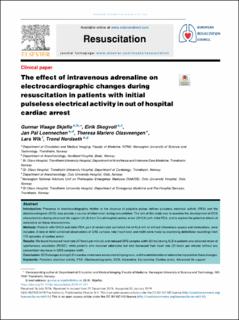| dc.contributor.author | Skjeflo, Gunnar Waage | |
| dc.contributor.author | Skogvoll, Eirik | |
| dc.contributor.author | Loennechen, Jan Pål | |
| dc.contributor.author | Olasveengen, Theresa M. | |
| dc.contributor.author | Wik, Lars | |
| dc.contributor.author | Nordseth, Trond | |
| dc.date.accessioned | 2021-04-30T09:02:27Z | |
| dc.date.available | 2021-04-30T09:02:27Z | |
| dc.date.created | 2019-04-14T07:53:52Z | |
| dc.date.issued | 2019 | |
| dc.identifier.citation | Resuscitation. 2019, 136 119-125. | en_US |
| dc.identifier.issn | 0300-9572 | |
| dc.identifier.uri | https://hdl.handle.net/11250/2740529 | |
| dc.description.abstract | Introduction
Presence of electrocardiographic rhythm in the absence of palpable pulses defines pulseless electrical activity (PEA) and the electrocardiogram (ECG) may provide a source of information during resuscitation. The aim of this study was to examine the development of ECG characteristics during advanced life support (ALS) from Out-of-hospital cardiac arrest (OHCA) with initial PEA, and to explore the potential effects of adrenaline on these characteristics.
Methods
Patients with OHCA and initial PEA, part of randomized controlled trial of ALS with or without intravenous access and medications, were included. A total of 4840 combined observations of QRS complex rate (heart rate) and width were made by examining defibrillator recordings from 170 episodes of cardiac arrest.
Results
We found Increased heart rate (47 beats per minute) and reduced QRS complex width (62 ms) during ALS in patients who obtained return of spontaneous circulation (ROSC); while patients who received adrenaline but died increased their heart rate (22 beats per minute) without any concomitant decrease in QRS complex width.
Conclusion
ECG changes during ALS in cardiac arrest were associated with prognosis, and the administration of adrenaline impacted on these changes. | en_US |
| dc.language.iso | eng | en_US |
| dc.publisher | Elsevier | en_US |
| dc.rights | Attribution-NonCommercial-NoDerivatives 4.0 Internasjonal | * |
| dc.rights.uri | http://creativecommons.org/licenses/by-nc-nd/4.0/deed.no | * |
| dc.title | The effect of intravenous adrenaline on electrocardiographic changes during resuscitation in patients with initial pulseless electrical activity in out of hospital cardiac arrest | en_US |
| dc.type | Peer reviewed | en_US |
| dc.type | Journal article | en_US |
| dc.description.version | publishedVersion | en_US |
| dc.source.pagenumber | 119-125 | en_US |
| dc.source.volume | 136 | en_US |
| dc.source.journal | Resuscitation | en_US |
| dc.identifier.doi | 10.1016/j.resuscitation.2019.01.021 | |
| dc.identifier.cristin | 1692326 | |
| cristin.ispublished | true | |
| cristin.fulltext | original | |
| cristin.qualitycode | 2 | |

